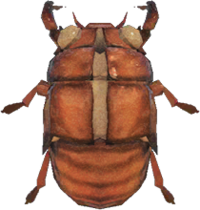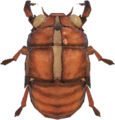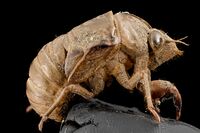Cicada shell
The cicada shell is a bug in the Animal Crossing series introduced in Animal Crossing: New Leaf. By definition, it is the exoskeleton left behind by a cicada nymph, making it the only bug in the series that is not living. Unlike other bugs, the player can run or walk past the tree without scaring the cicada shell away. The only way to make the bug disappear is to shake the tree or hit the tree with an axe, causing it to drop to the ground and disappear. In Animal Crossing: New Horizons, it can be found from mid to late summer.
Catch details[edit]
In New Leaf[edit]
| Time of year | Jul – Aug |
|---|---|
| Time of day | All day |
| Peak times | N/A |
| Location | On trees (hardwood and cedar) |
| Size | 40 mm |
| Rarity | Very common |
| Selling price | |
| Furniture size |
In New Horizons[edit]
| Time of year | North: Jul – Aug South: Jan – Feb |
|---|---|
| Time of day | All day |
| Location | On trees (hardwood and cedar) |
| Weather | Any weather |
| Spawn requirement | Catch 50 total bugs |
| Selling prices | |
| Furniture size |
Donating to the museum[edit]
In New Leaf[edit]
It can be found in the top section of the upper right room in the bug habitat of the museum, with the other cicadas.
In New Horizons[edit]
Once donated, the cicada shell can be found on the trees right in front of the entrance to the bug exhibit. They are also found in the second room nearby where ants are located, which may be referencing the 17-year periodical cicadas.
Gallery[edit]
Real-world information[edit]
Cicadoidea, cicadas, are a superfamily of true bugs consisting of over 3,000 species. A distinctive element of their life cycle is that they undergo incomplete metamorphosis, starting life as nymphs which continuously grow over their lifetimes before maturing into a fully developed, winged adult, lacking an intermediary pupal stage. After hatching, nymphs burrow underground, where they spend the majority of their lives and feed on sap from tree roots; depending on the species, this period lasts anywhere from two years to nearly two decades. In the leadup to maturation, the nymphs nocturnally surface and cling to trees, where they shed their exoskeletons and emerge in their mature forms. The adults then fly off to find mates and begin the life cycle anew, leaving behind the exuviae, which remain fastened to the surface where molting occurred. It is these abandoned exoskeletons which serve as the basis for cicada shells in the Animal Crossing series.
Names in other languages[edit]
| セミのぬけがら semi no nukegara |
Cicada's shell | |
| 매미 허물 maemi heomul |
Cicada shell | |
| 蝉蜕 chántuì |
Cicada shell | |
| 蟬蛻 Unknown |
||
| Кокон цикады Kokon tsikady |
Cicada cocoon | |
| Cicadehuid | Cicada skin | |
| Zikadenlarvenhaut | Cicada larva skin | |
| Muda de cigarra | Cicada molting | |
| Carcasa di cigarra | Cicada shell | |
| Mue de cigale | Cicada molting | |
| Esuvia di cicala | Cicada shell | |
Notes[edit]
| Bugs | |||||||||||||||||||
|---|---|---|---|---|---|---|---|---|---|---|---|---|---|---|---|---|---|---|---|
| |||||||||||||||||||





